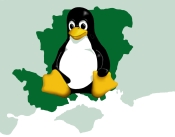|
|
imported from wiki, 24 February 2007
Installing Fedora Core 6
This guide is intended as a beginners guide to installing Fedora Core 6. I read a few webpages for tips before starting and found link below so please read it before continuing.
http://www.mjmwired.net/resources/mjm-fedora-fc6.html#install
So to begin
Download stage
Download FC6 for your particular hardware platform from here,
http://fedora.redhat.com/Download/
I chose to download all 5 CD’s however, I only used CD 1 and 2 during the installation. My collegues prefer to download a minimal install CD and add the extra packages they require over the network, using the [continued…]
imported from wiki, 20 February 2007
This page describes how to set up your system to use a suitable default encoding and character set, and to configure X to give you a keyboard map which will allow you to enter a selection of symbols and foreign characters.
Character sets, Unicode and UTF-8
First, a bit of background. You can skip this if you don’t want to know the details, but it may help to explain what’s going on.
Computers ultimately store all their information, including text, as numbers. In order to make it easy for people to read these numbers, they typically go [continued…]
imported from wiki, 18 February 2007 NVIDIA Driver Installation
If you’re planning on running software on Linux that utilises openGL, such as Blob and Conquer or XGL, you’ll need to ensure your graphics card drivers support hardware acceleration. If your card is made by NVIDIA, you’ll find that the open-source nv driver provided by X.org isn’t suitable. Fortunately, NVIDIA have packaged their drivers for easy installation on several platforms.
Getting the Drivers
To get NVIDIA’s proprietary drivers with support for hardware accelerated 3D, it’s as simple as going to http://www.nvidia.com/object/unix.html and clicking the link to the latest version for your platform (be [continued…]
imported from wiki, 17 February 2007 This guide was produced using Ubuntu Hoary 5.04 and Ubuntu Breezy 5.10, and Ubuntu Dapper 6.06. It’s also therefore applicable to Debian. Although most of the commands should work generically across different distributions.
Packages
Qemu packages are available in the Debian and Ubunutu repositories for version 0.6.1 or 0.7.0 (and 0.8.0 in Ubuntu Dapper 6.06), depending on what distribution and version you are using. Qemu also has an optional kernel module called KQemu, previously this was not redistributable (it now is) therefore packages for any Linux distribution may not include this module. The advantage of KQemu is much improved emulation [continued…]
imported from wiki, 17 February 2007 Warning
I would highly recommend that anyone wishing to compile QEMU from CVS should first look at the Qemu Compilation page. Specifically it would be wise to ensure their environment is setup correctly to enable them to compile QEMU from the latest stable version on the author’s home page before attempting this.
That said, there’s really very little difference between the procedure on this page and that on the Qemu Compilation page. It makes sense therefore for this page to only detail the differences rather than duplicate the entire compilation procedure as this [continued…]
imported from wiki, 12 February 2007
Quite a lot of people use the Mozilla Firefox web browser on Linux. One of the great features of Firefox is the extension capability. Additional functionality can be just a few clicks away. Here’s a list of some of our favourite plugins and why we like them.
[[https://addons.mozilla.org/extensions/moreinfo.php?id=60|Web Developer]]
Adds a menu and a toolbar with various web developer tools.
Proponents: AlanPope, DanPope, AdamTrickett
[[https://addons.mozilla.org/extensions/moreinfo.php?id=433|Flashblock]]
Never be annoyed by a Flash animation again! Blocks Flash so it won’t get in your way, but if you want to see it, just click.
Proponents: [continued…]
|
|
